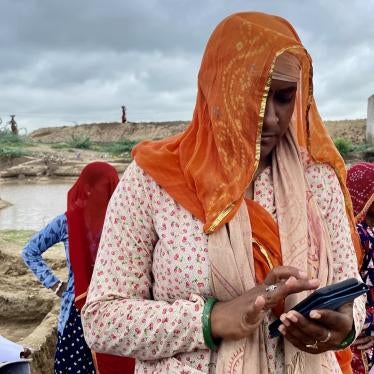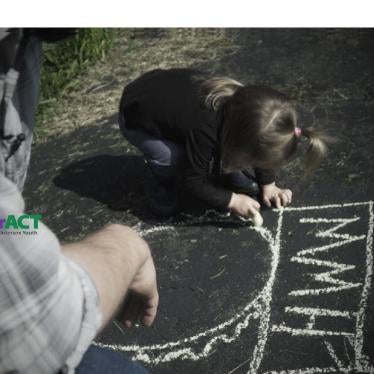(Tripoli) – Evidence indicates that forces loyal to Muammar Gaddafi killed at least 17 detainees in a makeshift prison as rebel forces began advancing on the neighborhood of Gargur in Tripoli around August 21, 2011, Human Rights Watch said today. According to one witness who survived the killing, Libyan security forces shot the detainees at the Al-Amal al-Akhdar building belonging to the Libyan Internal Security service.
Human Rights Watch has also documented evidence of suspected arbitrary executions of dozens of other civilians, including medical professionals, by Gaddafi loyalists over the past week.
“Torture was rife in Gaddafi’s prisons but to execute detainees days before they would have been freed is a sickening low in the government’s behavior,” said Sarah Leah Whitson, Middle East and North Africa director at Human Rights Watch said. “The evidence we have been able to gather so far strongly suggests that Gaddafi government forces went on a spate of arbitrary killing as Tripoli was falling.”
Separately, on August 26, Human Rights Watch found 18 bodies rotting in small groups near the Internal Security building in a dry riverbed between Gargur and Bab al-Aziziya, Gaddafi’s former compound. Witnesses told Human Rights Watch that Gaddafi forces had killed them at different times in the week prior to August 25, when Libyan rebels seized control of the area. It is unclear if any of those killed were armed at the time of their death, but Human Rights Watch observed two among the 18 bodies had their hands tied behind their backs and two were wearing the green scrubs of Libyan doctors and nurses. Witnesses told Human Rights Watch that several others were unarmed.
Human Rights Watch also documented 29 other bodies found in and around a makeshift field clinic outside Bab al-Aziziya where there were signs that Gaddafi loyalists had been present. Four bodies were found lying on beds in the clinic itself, and several more were lying on cushions in and around what looked like military tents. Volunteers took the bodies into trucks. Human Rights Watch inspected one corpse with a gunshot wound to the head, and one body with his hands tied behind his back. Khalid Kofran, 35, who volunteered on the team that was removing the bodies, said he had seen at least three or four corpses with their hands and legs tied. Human Rights Watch has not collected sufficient information to date to indicate who may be responsible for the deaths, and there is no forensic analysis yet.
“Just Finish Them Off”
Human Rights Watch interviewed three people with direct knowledge of the execution of detainees, including one survivor. Seventeen of the bodies were taken to the Matiga Hospital in Tripoli on August 24, according to medical professionals who inspected them.
On August 26, Human Rights Watch also examined two corpses that were still in place at the Al-Amal al-Akhdar Internal Security building in Gargur where the suspected execution of detainees took place.
Osama Hadi Mansur Al-Swayi was one of the survivors of the massacre at the Internal Security building. He was one of approximately 25 people who were held there. He told Human Rights Watch:
"The Khamis Brigade took me on August 19. One of the guards in the house [where they took me] told me that if I am innocent, Khamis could solve my problems. It happened at 2 p.m. on Monday [August 21]. We started hearing the rebels yelling Allahu Akbar. We were so happy, and we knew we would be released soon… Snipers were upstairs; then they came downstairs and started shooting. An old man [and another person] were shot outside our door. [The rest of us] ran out because they opened the door and said, “Quickly, quickly, go out.” They told us to lie down on the ground. When I opened my eyes, I saw three dark men. One soldier gave the order, “Just finish them off,” but I don’t know who it was. There were four of them who fired at us: one was an old man with a grey beard, and three were dark-skinned, maybe from the south. I was near the corner and got hit in the right hand, the right foot and the right shoulder. In one instant, they finished off all the people with me. What I saw I haven’t ever seen even in a movie. No one was breathing. Some of them had head wounds."
On August 26, Human Rights Watch also found two additional bodies in the closet under the stairs in the Al-Amal al-Akhdar Internal Security building where Al-Swayi said he had been detained for two days. Al-Swayi told Human Rights Watch that two men had also been killed on the ground floor where he was held just before the massacre, not in the courtyard. It could not be confirmed that these corpses were of the same men. There were dozens of spent cartridges and bloodstains on the ground in the outdoor courtyard where he said the majority of the detainees had been killed.
A medical professional who inspected the 17 bodies that were transferred from the Internal Security building to Matiga Hospital said that about half of the entrance wounds were to the back of the head, and the rest were to the chest and face. He also noted recent abrasions and lacerations on the ankles and wrists suggesting that they had been cuffed. The hospital administrator introduced Al-Swayi to Human Rights Watch as a survivor from the same massacre from which they received the 17 corpses.
Under international humanitarian law, violence to life and person, in particular murder of all kinds of civilians and persons not engaged in combat such as detainees is always strictly prohibited and constitutes a war crime. This is irrespective of whether the conflict is an international or non-international conflict.
“If he is a civilian, still kill him”
In addition, near the Internal Security building, Human Rights Watch inspected 18 bodies in situ rotting in a dry riverbed between Gargur and Bab al-Aziziya and interviewed five eyewitnesses.
In a suspected extra judicial execution by Gaddafi forces, Salah Saeed Kikli, 52, a medical laboratory engineer, told Human Rights Watch that he saw Gaddafi fighters in green military uniform kill two unarmed men, including one in medical scrubs, at a checkpoint by his home on August 24 around 11 a.m. after the fighters had previously approached him and threatened to kill him.
I was fixing my car. An African came to my corner [of the street] and asked if I was civilian or military. I said I live here. There was another [black man] behind who said, “if he is civilian, still kill him. No problem…” Five or ten minutes later… I saw them taking a doctor and another guy from an ambulance, and I saw them shoot [the two men]. The military guys stole the petrol from the ambulance… The ambulance said “February 17 Misrata” on it. [February 17 is a sign of support for the rebels.]…The men did not resist at all. They were medical people.
Another witness to the same incident, Juma’ Al-Murayd, 31, told Human Rights Watch that two people with dark skin and in civilian clothes were driving the ambulance when they dumped three bodies next to his house on the dry riverbed between Bab al-Aziziya and Gargur. Human Rights Watch inspected the three bodies with Kikli, across from Al-Murayd’s house, two of whom were wearing the green medical scrubs that doctors and nurses wear in Libya. Kikli said that the third body, dressed in civilian clothes, was that of the driver.
Al-Murayd also said that separately he had witnessed other Gaddafi fighters kill three more civilians on August 23 at a checkpoint across the riverbed from his home, after having beaten them with the butt of a Kalashnikov. “One of them was just driving his car, unarmed,” he told Human Rights Watch. Human Rights Watch inspected five bodies dumped in the riverbed near the spot Al-Murayd identified as the location of the checkpoint where the three men were executed. Human Rights Watch does not have evidence to date of how the other two were killed. All five bodies were dressed in civilian clothes.
In another incident in the same area, Siraj Salah Kikli, 18, told Human Rights Watch that he witnessed a policeman from Dam el-Merkezi kill two people and then spoke to a third who survived the shooting. He said that the policeman, whom he knew, was wearing civilian clothes and a military flak jacket. He and another man had forced the three victims to get out of their vehicle. “They didn’t beat them,” Siraj Kikli recalled, “they just shot them straight away.” The bodies were removed from the site on August 25.
Adel Muhammad Abdulgader, 36, also said he witnessed Gaddafi forces kill two men in a vehicle stopped at a checkpoint, ostensibly because one of the men was wearing a rebel hat, which the forces took and burned. He said that the incident took place on August 22 or 23 at 7 a.m.
“These incidents, which may represent only a fraction of the total, raise grave questions about the conduct of Gaddafi forces in the past few days, and whether it was systematic or planned,” said Whitson. “If these incidents are proven to be extra judicial killings they are serious war crimes and those responsible should be brought to justice.”






